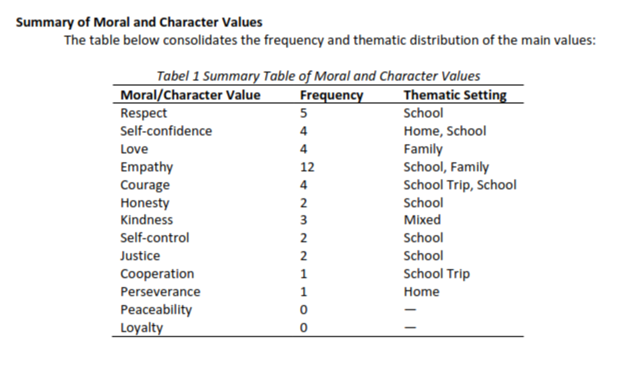An Analysis of Moral Values and Character Education in 'Wonder' Movie
DOI:
https://doi.org/10.30736/ej.v12i01.1213Keywords:
Moral Values, character education, Film WonderAbstract
The title of this research is An Analysis of Moral Values and Character Education Depicted in the Film Wonder. This research addresses the issue of declining moral values among youth, as reflected in the increasing prevalence of bullying and intolerance in educational settings. This research aims to examine how the 2017 film Wonder can be utilized as a medium for teaching moral values and character education. Specifically, the study investigates how selected scenes, character dialogues, and interactions portray ethical principles and personal virtues. Descriptive qualitative method and content analysis are used as a research method; the data were categorized and interpreted through Eyre’s framework, which outlines eleven core moral values and Lickona’s theory of character education, which emphasizes the development of virtues such as empathy, courage, and respect in formal learning contexts. Data were collected by analyzing the film’s script and narrative structure, identifying key moments where moral and character values were evident. The analysis reveals that Wonder frequently portrays values such as respect, self-confidence, and love, with empathy emerging as the most dominant character trait. These findings suggest that films like Wonder can be effectively integrated into classroom instruction to foster moral reasoning, empathy, and emotional intelligence, thus supporting the development of ethically aware and socially responsible learners.
Downloads
References
Apriliana, A. K. (2022). An Analysis of Moral Value in “Imperfect” Movie. Al’Adzkiya International of Education and Social (AIoES) Journal, 3(1), 88–95. https://doi.org/10.55311/aioes.v3i1.184
Azi, R., Muarif, M., Sofian, N. I., & Kalsum, U. (2022). Moral Values of the Main Character in the Yellowbird Movie. JoLLA: Journal of Language, Literature, and Arts, 2(8), 1139–1147. https://doi.org/10.17977/um064v2i82022p1139-1147
Brilianti, A. E. (2023). The Representation of Character Education in the Movie Sang Prawira Based on Thomas Lickona’s Theory. Pioneer: Journal of Language and Literature, 15(2), 388. https://doi.org/10.36841/pioneer.v15i2.3242
Eyre, L. E. and R. (1993). Teaching Your Children Values. Fireside (Simon & Schuster).
Imam Tabroni, Rendy Afrizal, Elsa Nurmawati, Siti Nurlatifah, & Siti Nurlatifah. (2021). Character Building: An Answer To the Worsening of Human Character? SOKO GURU: Jurnal Ilmu Pendidikan, 1(3), 11–14. https://doi.org/10.55606/sokoguru.v1i3.57
John Creswell. (2013). Educational Research - Planning, Conducting, And Evaluating Quantitative and Qualitative Research - Fifth Edition. In AORN Journal (Vol. 62, Issue 1).
Kusramadhani, S., Nirwanto, R., & Widiastuty, H. (2022). Moral Values in English Textbook: “When English Rings a Bell.” PROJECT (Professional Journal of English Education), 5(2), 344. https://doi.org/10.22460/project.v5i2.p344-353
Laila, F. N., Adityarini, H., & Maryadi, M. (2023). Challenges and Strategies in Teaching English Speaking Skills to Young Learners: Perspectives of Teachers in Indonesia. VELES (Voices of English Language Education Society), 7(3), 542–556. https://doi.org/10.29408/veles.v7i3.24030
Lickona, T. (1991). Educating for Character: How Our Schools Can Teach Respect and Responsibility. Bantam Books. https://books.google.de/books/about/Educating_for_Character.html?id=cQqfAAAAMAAJ&redir_esc=y
Maya, L., & Iskandar, I. (2022). English Language Teaching Praxes and Policies in Indonesia : A Critical Review. Proceedings International Conference on Teaching and Education (ICoTE), 3, 50–55. https://jurnal.untan.ac.id/index.php/icote/article/view/56081
Nadeak, L., Simbolon, M., Sihotang, R. Y., Sembiring, Y. B., & Panaluan, T. (2020). Moral Values and Character Building Exposed in the Folklore of Tongkat Tunggal Panaluan. Jurnal Pendidikan Bahasa Inggris Undiksha, 8(2), 92–96. https://ejournal.undiksha.ac.id/index.php/JPBI/article/view/30969
Purba, A. R., Ningtias, N. A., Ginting, L. S., Tarigan, M. S., & Br Sembiring, E. M. (2022). Moral Value and Character Education in the “Cars” Movie. IDEAS: Journal on English Language Teaching and Learning, Linguistics and Literature, 10(2), 1331–1343. https://doi.org/10.24256/ideas.v10i2.3204
Qatrinada, C., & Apoko, T. W. (2024). Exploring The Use of Narrative Texts in Teaching Writing for EFL Classroom. Edulitics (Education, Literature, and Linguistics) Journal, 9(1), 62–74. https://doi.org/10.52166/edulitics.v9i1.6536
Sembiring, Y. B., Purba, V. A., Panjaitan, T. M., Sitorus, L. D., & Sijabat, A. P. (2021). Moral Value and Character Building Education in Film: Denias, Senandung di Atas Awan. Jurnal Ilmiah Wahana Pendidikan, 7(8), 572–579. https://doi.org/10.5281/zenodo.5793138
Sulayani, N., Sitohang, L., Simbolon, L. O., & Tarigan, M. S. B. (2021). Moral Value and Character Education Found in the Movie Miracle in Cell No. 7. Edukatif : Jurnal Ilmu Pendidikan, 4(1), 162–169. https://doi.org/10.31004/edukatif.v4i1.1753
Wibowo et al. (2021). Fenomena perilaku. Cakrawala Ilmiah Mahasiswa, 1(2), 157–166. https://doi.org/10.30998/ocimxxxxxx

Downloads
Published
How to Cite
Issue
Section
License
Copyright (c) 2025 Dinda Ayu Saputri Dinda, Chusnul Chotimah, Hana Amanda

This work is licensed under a Creative Commons Attribution 4.0 International License.








